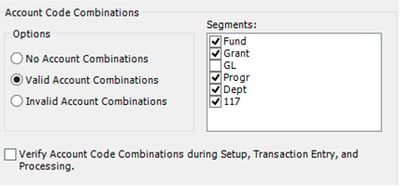Ready for some more summertime projects? As we indicated last month, summer is often a great time to tackle some of those software cleanup projects that you've been putting off. In this blog, we'll help you setup account code combinations in your Abila MIP Fund Accounting™ › software.
Account code combinations is a feature in MIP that can help you to reduce data entry coding issues. When you turn on Account Code Combinations, the system will not allow you to post transactions to an invalid account string. It takes a little bit of planning and setup time, but once it's done it's fairly easy to maintain.
To start using the feature, you need to make a couple of decisions on how to use it.
- You can specify which account segments should be included in the validation. You may want to use the feature to just validate a department and grant segment, but not the general ledger code.
- Second, you need to determine whether you want to have the system check for valid codes, or check for invalid codes.
- If you choose valid codes, you will specify all the account combinations you want to use in your system. If a user enters a string that is not in the list of valid codes, they will be prevented from entering the transaction.
- If you choose invalid codes, you will enter a list of all of the strings you do not want users to enter. If a user enters a string that is in the list of invalid codes, they will be prevented from entering the transaction.
Which option should you use? It depends. If you are simply trying to prevent people from accidentally coding un-allowable transactions on a couple of grant values, you should probably use the Invalid code method, since it will be easier to list all of the transactions you don't want to allow. If you have very specific coding requirements, it may be more valuable to use valid codes, and enter all of the strings you want people to use. It may take more time to set up, but it will be more helpful in the end.
To turn on the feature, go to Administration>Organization>Organization Preferences. On the Processing tab, there are three options for Account Code Combinations:
- No Account Combinations (feature is turned off);
- Valid Account Combinations; or
- Invalid Account Combinations.
Choose the option you want, and on the right, check the boxes next to the segments you want included in the validation. Leave the option to "Verify Account Code Combinations during Setup, Transaction Entry, and Processing" unchecked, while you are entering your valid or invalid strings. This will allow people to still enter transactions while you are finishing entering the strings.

Once you have turned on the feature, now you need to enter the valid or invalid strings. Go into the Accounting module, and go to Maintain>Account Code Combinations. Here, enter all of the strings you want to have the system verify when users are entering transactions.
After you have set up all of your valid or invalid codes, you can now check the “Verify Account Code Combinations during Setup, Transaction Entry, and Processing” option to activate the feature in the system. Once activated, users will be prompted if they try to use an account code combination that is not allowed.
Bonus Tip: To maintain combinations as you add new segment values, if you use the Chart of Accounts Wizard when creating new values, you can specify a model value at the end, and copy the combinations from that model account to the new value.
Soft Trac is a woman-owned business and accomplished team of nonprofit software consultants. We believe in making nonprofits "do good" better.
Copyright © 2015 Abila, Inc. All Rights Reserved. Abila MIP™, Abila MIP Fund Accounting™, and True Fund Accounting™ (Any other products they represent) are trademarks and registered trademarks of Abila, Inc. in the United States and other countries. All other product names mentioned herein are the trademarks of their respective owners.













